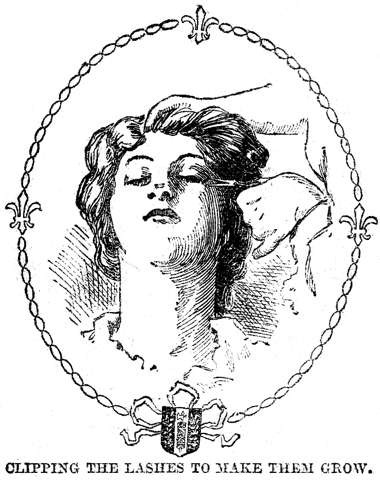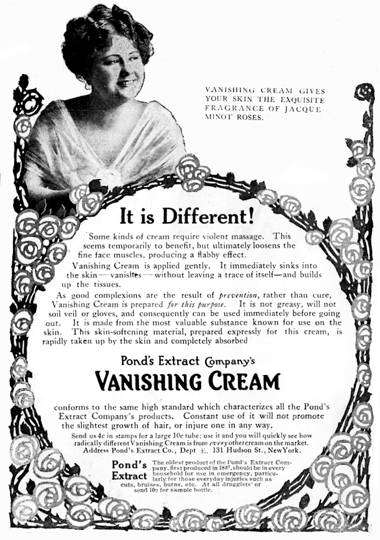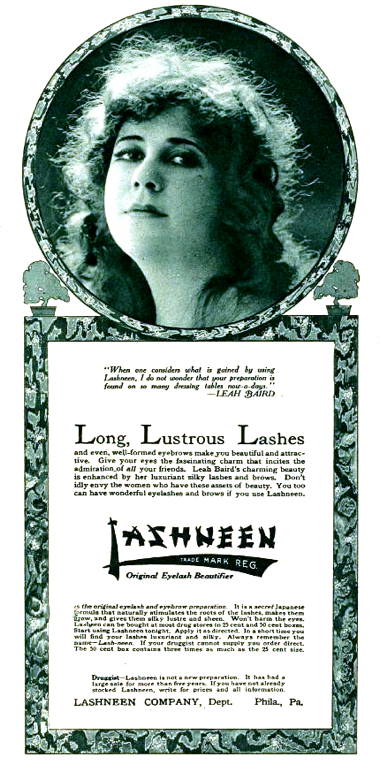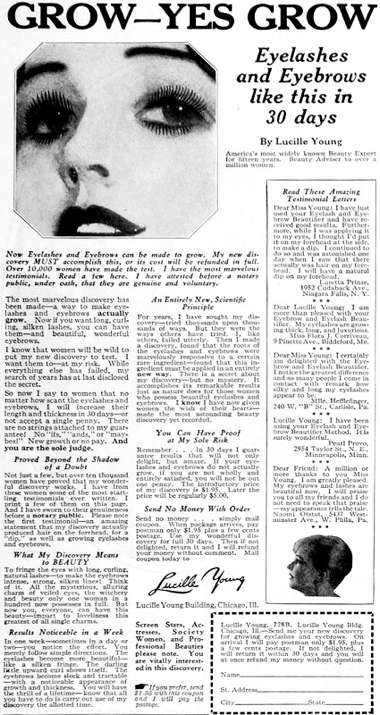Eyelash Growers
Women often go to great lengths to remove facial hair but there is one place on their face where there never seems to be enough, their eyelashes. Nineteenth century sources contain a number of treatments to encourage the growth of eyelashes some of which were also used on eyebrows.
Clipping
Regularly trimming – called clipping or tipping – was one of the oldest practices said to promote the growth of lashes. To give it extra credibility, it was sometimes described as being a secret from far off-lands where lashes were known to be long and black.
It is no less strange than true, however, that European beauties are quite inattentive to the growth of their eye-lashes; though in Circassia, Georgia, Persia, and Hindostan, it is one of the first objects of a mother’s care to promote the growth of her children’s eye-lashes. If hair be left to itself, it seldom grows long; but either splits at the top into two or more forks, or becomes smaller and smaller till it ends in a fine gossamer point. When it does so it never grows any longer, but remains stationary. The Circassian method of treating the eye-lashes is founded on this principle. The careful mother removes, with a pair of scissors, the forked and gossamer-like points (not more) of the eye-lashes, and every time this is done their growth is renewed, and they become long, close, finely curved, and of a silky gloss. This operation of tipping may be repeated every month or six weeks. The eye-lashes of infants and children are best tipped when they are asleep. Ladies may, with a little care, do the office for themselves. This secret must be invaluable to those whose eye-lashes have been thinned and dwarfed, as often happens from inflammation of the eyes.
(The toilette of health, beauty, and fashion, 1832, pp. 331-332)
This was a difficult to do solo, so many authors thought that it was best done by a friend with a steady hand.
Growth of the eyelashes is greatly improved by clipping them at regular intervals for a few months. As the task requires a firm, confident touch it is easiest done by another, yet can, if necessary, be done by one’s self. Long, outward-curling lashes are a very great beauty in themselves, besides affording great protection to the eye, and a good deal of painstaking care is worth while.
(Fletcher, 1901, p. 388)
Fortunately, the practice of clipping eyebrows or eyelashes seems to have largely died out in the early twentieth century although you can still find some advocates of the practice today. However, the myth that cutting hair stimulates growth lived on much longer when it came to leg hair.
Various authorities advise cutting the hair with scissors close to the skin, believing that this is one of the best and simplest ways of removing the growth temporarily. Shaving, however, is a method that stimulates a stronger growth of hairs and, furthermore, in brunettes, after this process a tiny area about the individual hair sometimes takes on a darker hue.
(Harpers Bazaar, October 1913, p. 40)
It is easy to see why this myth persisted with leg hair. Hair that has not been cut has a pointed end which is often partly bleached by sunlight and other environmental factors. When shaved, the end becomes blunt, and the hair that emerges looks stronger and darker than the end that was removed. This led to the idea that shaving the legs thickened and coarsened the hair and stimulated its growth. None of this is true, as any balding man who has shaved his head will attest.
Lash growers
Oils and pomades were also considered hair growers, perhaps because they darkened the hair and made it appear more luxurious. Suitable ingredients for eyelash growers included lanolin, turtle oil, olive oil, castor oil, lecithin and cholesterin but many commercial products were simply made from petroleum jelly or mineral oil.
Petroleum oil applied on a tiny brush will improve the growth of scant eyebrows.
Oil of rose will promote the growth of scant brows. Do not let it get into the eyes, as it will irritate them.
Vaseline is another for scant brows.
Try the following if all else fails:
Red Vaseline grams 5 Boric Acid centigrams 8 Mix into a smooth paste and apply to the skin under the brows.
Do not clip the eye brows to promote their growth, as it coarsens them, and always wipe or brush them from the nose outward.(Furlong, 1914, pp. 94-95)
Lanolin and petroleum jelly (Vaseline) were considered particularly efficacious.
For making the eyebrows and eyelashes grow thick and strong there is nothing so good as lanoline, the cholesterin content is possibly the reason. An example is: — Anhydrous lanoline 450, sweet almond oil 300, cocoa butter 50, melt by gentle warmth and whisk in thoroughly 200 of rose water. Tissue creams of petroleum jelly and lanoline bases are recommended, also oils such as paraffin, almond or olive, simply tinted, not perfumed.
(P&EOR, 1932, p. 376)
Petroleum jelly and lanolin were so widely regarded as hair growers that face creams containing these and other oils that some considered that they could produce facial hair.
Brunettes are more prone than blondes to the affliction of superfluous hair, especially in the form of a downy growth, but coarse hairs on the face may be seen in both types. Certain diseases cause an increased growth of hair. In rare instances, irritation of the skin, is the cause for a local growth of hair.
The daily use of cold cream and the attendant massage may increase the growth of hair on skins which are predisposed to such growth. The occasional use of a good cleansing cream will do no material harm, but its daily use is to be deplored.
If the growth is due to to some condition of ill-health, which is duly corrected, the appearance may be temporary; it is however more likely to be permanent.(Harpers Bazaar, October 1913, p. 40)
The widespread belief in this myth saw many manufacturers placing disclaimers in their advertising to refute claims that their face cream would stimulate hair growth.
Constant use of it will not promote the slightest growth of hair, or injure one in any way.
(Pond’s advertisement, 1911)
The myth that oils and pomades would stimulate hair growth continued well into the twentieth century and was only killed off when regulatory authorities began to prosecute companies, like Charles Antell, for making untrue claims.
Coloured eyelash growers
Eyelash growers were used in two main ways. Some were applied to the upper and lower lids of the eye but others were used directly on the eyebrow and eyelash hair. Many contained a colouring agent. Coloured eyelash growers used on the eyelids would have darkened the area around the eye acting like an eyeshadow while those that darkened the eyebrows and eyelashes worked like a mascara.
Eyebrow and Lash Growers. Most of the preparations which are “guaranteed to produce long, silky, ravishingly beautiful eyelashes,” consist of plain white petroleum jelly (Vaseline) with or without a little perfume and coloring matter. Their efficacy is purely problematical. The individual hairs on the brows and the lashes attain a definite fore-ordained length, then drop out and other hairs take their places. If lanolin is present the paste is slightly stiffer. In any case the illusion of greater length is effected through the fact that such greases always make the hairs stand more erect. If coloring matter is present in the paste, the lashes are darkened and thus appear more conspicuous.
(Wall, 1926, p. 193)
Some manufacturers who started out making eyelash and eyebrow growers went on to make true mascaras. Maybelline progressed in this manner. Its first product, Lash-Brow-Ine, a colourless cream advertised as being able to ‘nourish and promote the natural growth of eyelashes and eyebrows’ was replaced with coloured Maybelline which would ‘beautify the eyelashes and eyebrows instantly’.
See also: Maybelline
Eyelash growers continued to be retailed by cosmetic companies until 1940s at least. For example, in the 1930s, Helena Rubinstein sold an Eye Lash Grower Cream and an Eye Lash Cream and Darkener, and Elizabeth Arden sold Ardena Stimulash, a black cream to ‘enhance the beauty of the eyebrows and lashes that can be applied with or without mascara’. The Wheeler-Lea Act and The Food, Drug and Cosmetic Act of 1938 enabled U.S. authorities to charge products like this with “exaggerated, false and misleading representations” (AMA, 1942) so, these products disappeared in the United States after 1938. The same was not true in other countries and eyelash growers persisted elsewhere for some time after the Second World War.
See also: The FDA, FTC and Cosmetics
In recent years, a number of new products claiming to be lash and brow growers have appeared on the market. Most are sold as serums. However, any product that could extend the growth stage of a hair follicle – on the eyelashes or anywhere else – would be classified as a drug not a cosmetic. So, unless the product is prescribed by a doctor or is listed as an over-the-counter (OTC) drug, scepticism is highly advised, especially when you consider that you will need to keep using them for any effect to be maintained.
First Posted: 29th October 2012
Last Update: 4th December 2023
Sources
The American perfumer & essential oil review. (1906-1955). New York: Robbins Perfumer Co. [etc.].
Fletcher, E. A. (1901). The woman beautiful. A practical treatment on the development and preservation of woman’s health and beauty, and the principles of taste in dress. New York: Bretano’s
Forget-me-not: A pictorial journal for ladies. (1901). London.
Furlong, P. (1914). Beauty culture at home. Washington: Author.
Journal of the American medical association. (1883-present). Chicago.
Powder Puff. (1922). Beauty & Health. London: Chapman & Dodd, Ltd.
The toilette of health, beauty, and fashion. (1834). Boston: Allen and Ticknor.
Wall, F. E. (1926). Canitics. The treatment of canities reduced to a science and elevated to an art. New York: Beautician Publications.

1901 Clipping the lashes to make them grow.

1901 Eyelashes should be brushed with a tonic

1911 Ponds Vanishing Cream with the disclaimer that its use will not result in hair growth.

1920 Lasheen.

1927 Lucille Young’s secret to growing eyelashes and eyebrows.
 1927 Laleek Longlash. A mascara with lash growing claims.
1927 Laleek Longlash. A mascara with lash growing claims.

1932 Kurlash Kurlene. The marvelous German discovery was probably a form of lanolin.
